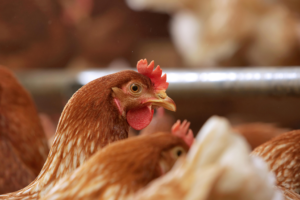Poultry farmers reminded to be mindful of red mite during housing order
29th November 2022
MSD Animal Health UK Ltd is urging poultry producers to continue monitoring for red mite among flocks as the housing order comes into effect across England.

Warmer temperatures creates favourable conditions for red mite populations to thrive
“Normally, during the winter period when the weather is cooler, red mite activity declines,” says Katie Pitman, Technical Poultry Manager at MSD Animal Health UK. “However, with the housing order requiring birds to be kept indoors at all times, with pop holes closed, this creates favorable conditions for red mite populations to thrive.”
“The birds will already be stressed due to being permanently housed, and so producers don’t want to add to this pressure by not keeping on top of red mite,” urges Ms. Pitman.
Birds affected by red mite can display restlessness, weight loss and a drop in egg production and quality. In extreme cases the parasite may also cause anemia and mortality. Additionally, red mite suppresses a bird’s immune system, meaning chickens affected by high infestations are more susceptible to other infections.
Producers should not rely on birds displaying symptoms as an indicator of a red mite infestation. “Red mite are typically more active at nighttime and often feed when the house lights are off, making it hard to visually assess whether you have an issue. Producers should place traps to accurately quantify the threat to flocks,” recommends Ms. Pitman.
Producers can create their own simple red mite traps made from corrugated card which is rolled up and inserted into a plastic tube, similar in diameter to a water pipe. They should be placed strategically around the shed where red mite are likely to travel at night, such as near nesting boxes or perches. After 48 hours, the traps can be collected, put into individual bags, and placed in the freezer for a further 48 hours to kill the mites, making it easier to count the number of mites.
There are various thresholds to be aware of when monitoring red mite which indicate levels of infestation. Producers are advised to speak to a veterinary professional for advice on treatment if infestation levels are deemed high. A suitable product can then be recommended, along with other management tools.
“It’s recommended that monitoring is continued throughout the period the housing order is in place because by the time an infestation is noticeable, it’s likely that flock productivity and welfare have already been compromised,” explains Ms. Pitman.
Alongside monitoring, proactive biosecurity measures are essential to help prevent red mite infestations from spreading in the first place. For example, keeping equipment clean and avoiding sharing of equipment between poultry sheds is advised. Providing clean footwear and overalls for all team members to wear in each shed and limiting external visitors on the site should also be considered.
